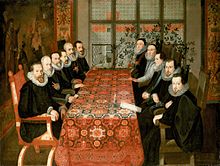Treaty of London (1604)
The Treaty of London in 1604 ended the Anglo-Spanish War from 1585 to 1604 . The peace treaty was signed on August 28, 1604 on the English side by Thomas Sackville , Charles Howard , Charles Blount, Henry Howard and Robert Cecil , on the Spanish side by Juan de Velasco , Juan de Tassis, Alessandro Robido, Charles de Ligne , Jean Richardot and Louis Verekyn.
conflict
The beginning of the war between Spain and England , which was never officially declared , was the support of the insurgent Dutch in 1585 by English troops and the English attack on Spanish possessions in the West Indies by Francis Drake . The climax of the war was the failed attempt to invade the Spanish armada of Philip II in 1588. In 1589, an English armada launched an equally unsuccessful counterattack on Lisbon . There were other similar English undertakings against Spanish colonies overseas (West Indies 1595) or against the Iberian Peninsula ( conquest of Cádiz 1596) itself. For their part, the Spaniards tried several times to land troops in Ireland to support the rebels there. Don Juan de Aguila only managed to do this briefly in 1601 at the end of the Nine Years' War .
Peace treaty
The Spanish King Philip II had died in 1598. His son and successor Philip III. wanted to end the long war against the background of the difficult economic situation in Spain. On the English side, too, people were increasingly tired of war. Initial negotiations between the two sides failed due to excessive English demands.
Against the background of the impending death of Elizabeth I , no more English ships ran against Spain in 1603. After his accession to the throne, the new English king James I saw the most urgent task to end the war with Spain. He announced an anti-piracy law in the autumn of 1603. Subsequent negotiations on a peace agreement took place at Somerset House on the Strand in London. They lasted from May to August 1604.
A breakthrough in the negotiations was achieved as early as July 1604. Among other things, it was agreed to return looted goods or to pay compensation for them. Furthermore, Spain refrained from supporting the Counter-Reformation in England. In return, England promised not to support the rebels in the Netherlands any further. English privateer actions were also banned. For this, the English Channel was opened to Spanish ships. The treaties were approved by the two governments, and the treaty was signed on August 28, 1604.
Web links
- 1604 VIII 28_18 Peace Treaty of London. Contract text. Simancas AG, digitized. Retrieved September 13, 2018 .
Individual evidence
- ↑ Christoph Driessen: History of the Netherlands, From the sea power to the trend country. Regensburg 2009, p. 50 f.
- ↑ Michael Kempe: Pirates as Shaper of International Law? A look at early modern peace and armistice treaties. (Online version) ( Memento from September 25, 2013 in the Internet Archive )
